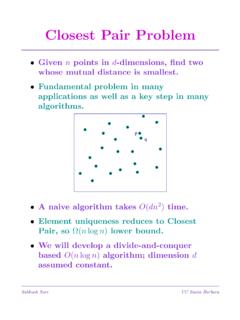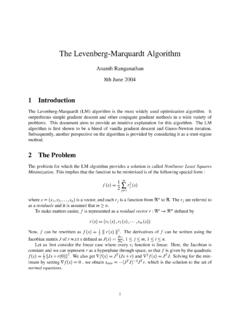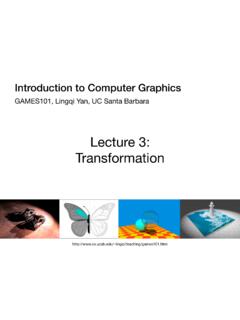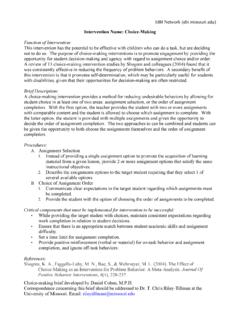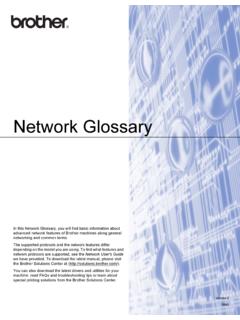Transcription of A Brief History of the Internet - sites.cs.ucsb.edu
1 Barry M. Leiner* Former Director Research Institute for Advanced Computer Science Robert E. Kahn President CNRI Jon Postel* Former Director USC ISI ABSTRACT This paper was first published online by the Internet Society in December 20031 and is being re-published in ACM SIGCOMM Computer Communication Review because of its historic import. It was written at the urging of its primary editor, the late Barry Leiner. He felt that a factual rendering of the events and activities associated with the development of the early Internet would be a valuable contribution. The contributing authors did their best to incorporate only factual material into this document.
2 There are sure to be many details that have not been captured in the body of the document but it remains one of the most accurate renderings of the early period of development available. Categories and Subject Descriptors [Network Architecture and Design]: Packet-switching networks. General Terms Design, Experimentation, Management. Keywords Internet , History . 1. INTRODUCTION The Internet has revolutionized the computer and communications world like nothing before. The invention of the telegraph, telephone, radio, and computer set the stage for this unprecedented integration of capabilities. The Internet is at once a * Deceased 1 David D.
3 Clark Senior Research Scientist MIT Daniel C. Lynch Founder CyberCash Inc, Interop Stephen Wolff Business Development Manager Cisco world-wide broadcasting capability, a mechanism for information dissemination, and a medium for collaboration and interaction between individuals and their computers without regard for geographic location. The Internet represents one of the most successful examples of the benefits of sustained investment and commitment to research and development of information infrastructure. Beginning with the early research in packet switching, the government, industry and academia have been partners in evolving and deploying this exciting new technology.
4 Today, terms like and trip lightly off the tongue of the random person on the street2. This is intended to be a Brief , necessarily cursory and incomplete History . Much material currently exists about the Internet , covering History , technology, and usage. A trip to almost any bookstore will find shelves of material written about the Internet3. In this paper4, several of us involved in the development and evolution of the Internet share our views of its origins and History . 2 Perhaps this is an exaggeration based on the lead author's residence in Silicon Valley. 3 On a recent trip to a Tokyo bookstore, one of the authors counted 14 English language magazines devoted to the Internet .
5 4 An abbreviated version of this article appears in the 50th anniversary issue of the CACM, Feb. 97. The authors would like to express their appreciation to Andy Rosenbloom, CACM Senior Editor, for both instigating the writing of this article and his invaluable assistance in editing both this and the abbreviated version. A Brief History of the Internet Vinton G. Cerf Chief Internet Evangelist Google Leonard Kleinrock Professor of Computer Science UCLA Larry G. Roberts Chairman and CEO Anagran, Inc This article is an editorial note submitted to CCR. It has NOT been peer reviewed. The authors take full responsibility for this article's technical content.
6 Comments can be posted through CCR Online. ACM SIGCOMM Computer Communication Review22 Volume 39, Number 5, October 2009 This History revolves around four distinct aspects. There is the technological evolution that began with early research on packet switching and the ARPANET (and related technologies), and where current research continues to expand the horizons of the infrastructure along several dimensions, such as scale, performance, and higher level functionality. There is the operations and management aspect of a global and complex operational infrastructure. There is the social aspect, which resulted in a broad community of Internauts working together to create and evolve the technology.
7 And there is the commercialization aspect, resulting in an extremely effective transition of research results into a broadly deployed and available information infrastructure. The Internet today is a widespread information infrastructure, the initial prototype of what is often called the National (or Global or Galactic) Information Infrastructure. Its History is complex and involves many aspects - technological, organizational, and community. And its influence reaches not only to the technical fields of computer communications but throughout society as we move toward increasing use of online tools to accomplish electronic commerce, information acquisition, and community operations.
8 2. ORIGINS OF THE Internet The first recorded description of the social interactions that could be enabled through networking was a series of memos written by Licklider of MIT in August 1962 discussing his Galactic Network concept [9]. He envisioned a globally interconnected set of computers through which everyone could quickly access data and programs from any site. In spirit, the concept was very much like the Internet of today. Licklider was the first head of the computer research program at DARPA5, starting in October 1962. While at DARPA he convinced his successors at DARPA, Ivan Sutherland, Bob Taylor, and MIT researcher Lawrence G. Roberts, of the importance of this networking concept.
9 Leonard Kleinrock at MIT published the first paper on packet switching theory in July 1961 [6] and the first book on the subject in 1964 [7]. Kleinrock convinced Roberts of the theoretical feasibility of communications using packets rather than circuits, which was a major step along the path towards computer networking. The other key step was to make the computers talk together. To explore this, in 1965 working with Thomas Merrill, Roberts connected the TX-2 computer in Mass. to the Q-32 in California with a low speed dial-up telephone line creating the first (however small) wide-area computer network ever built [10]. The result of this experiment was the realization that the time- shared computers could work well together, running programs and retrieving data as necessary on the remote machine, but that the circuit switched telephone system was totally inadequate for the job.
10 Kleinrock's argument for packet switching was confirmed. 5 The Advanced Research Projects Agency (ARPA) changed its name to Defense Advanced Research Projects Agency (DARPA) in 1971, then back to ARPA in 1993, and back to DARPA in 1996. We refer throughout to DARPA, the current name. In late 1966 Roberts went to DARPA to develop the computer network concept and quickly put together his plan for the ARPANET , publishing it in 1967 [11]. At the conference where he presented the paper, there was also a paper on a packet network concept from the UK by Donald Davies and Roger Scantlebury of NPL.
